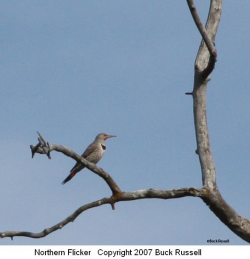
Courtesy & © 2007 Buck Russell
Have you ever woken up to this sound [Flicker pounding on a roof] and wondered what in the world was going on? This is the sound of the Northern Flicker, a large, ant-eating woodpecker found in open woodlands, savannas, and forest edges throughout North America.
The western subspecies, the Red-shafted Flicker, can be found year round in Utah. Its largish brown body with spotted breast, and thin dark bars across its back are unmistakable. Both sexes have a black collar and a red spot on the head—males on the back of the head and females on the side.
Breeding season is when you’d be most likely to hear the flicker drumming loudly on your house or nearby trees. Flickers—like other woodpeckers–drum to attract mates and defend territory—they are not looking for food. Both sexes drum and you’ll usually hear the drumming in conjunction with their Long Call, [ play long call]
Flicker drumming is produced by rapidly and sharply beating the tip of the bill on some sort of resonating object, usually a dead tree, limb or branch, sometimes a metal surface. They will use aluminum siding, as well as the trim and fascia boards of wood, brick, and stucco homes. They’ll also go for metal downspouts, gutters, chimneys, and vents.
Scientists have measured just over one second as the average duration of drum roll, with averages of 22 to 25 total beats in drum roll.
Does it hurt the little fellow to bang his head repeatedly across a hard surface? No. Flickers and other woodpeckers have thickened skulls and powerful neck muscles that enable them to deliver sharp blows without damaging their internal organs. A spongy, elastic tissue connects these flexible joints between the beak and the skull acting as a shock absorber. Bristly feathers around the nostrils help filter out the wood dust created as the flicker pounds away.
Luckily for homeowners, holes made by drumming activities are usually just small, shallow dents in the wood. And the drumming usually stops once breeding begins in the spring. For the most part, flickers spend their time digging in the ground slurping ants with their long tongues. If a flicker really starts to get on your nerves—there are some things you can do to discourage his behavior–like hanging Mylar reflective tape or streamers to the area where he likes to drum. Personally, the sound doesn’t bother me once I know the source is an attractive bird whose taste in real estate just happens to be the same as mine.
Credits:
Audio: American Flicker sound courtesy Xeno-Canto.org, recorded by Ryan O’Donnell.
Formerly: American Flicker sound for this recording used by permission of the copyright holder Kevin Colver and found in the Western Soundscape Archive at the University of Utah J. Willard Marriott Library. https://westernsoundscape.org/ Dr. Colver’s Soundscape albums are also available for download from WildSanctuary.com.
Photo: Used by Permission of the photographer Buck Russell, Bridgerland Audubon Member
Text: Bridgerland Audubon Society: Lyle Bingham, Bridgerland Audubon Society, Holly Strand Stokes Nature Center
Voice: Richard (Dick) Hurren, Bridgerland Audubon Society
Additional Reading
Northern Flicker, All About Birds, Cornell Lab of Ornithology, Cornell University, https://www.allaboutbirds.org/guide/Northern_Flicker/
Northern Flicker, Utah Species, Utah Conservation Data Center, Utah Division of Wildlife Resources, State of Utah, https://dwrcdc.nr.utah.gov/rsgis2/search/Display.asp?FlNm=colaaura
Complete Birds of North America, ed. Jonathan Alderfer, National Geographic, 2006, https://www.amazon.com/National-Geographic-Complete-Birds-America/dp/0792241754/ref=pd_bbs_sr_1?ie=UTF8&s=books&qid=1213078747&sr=8-1
Moore, William S. Wiebe, Karen L. Northern Flicker (Colaptes auratus), The Birds of North America Online (A. Poole, Ed.). Ithaca: Cornell Lab of Ornithology; Retrieved from the Birds of North America Online: , March 4, 2020 https://birdsoftheworld.org/bow/species/norfli/cur/introduction
Andelt, W.F., Hopper, S.N., and Cerato, M (8/14),(Revised by M. Reynolds), Preventing Woodpecker Damage – 6.516 , Colorado State University Extension, https://extension.colostate.edu/topic-areas/natural-resources/preventing-woodpecker-damage-6-516/
Woodpeckers, Texas Parks & Wildlife, State of Texas, https://www.tpwd.state.tx.us/publications/nonpwdpubs/introducing_birds/woodpeckers/
Link, Russell, Urban Wildlife Biologist, Living with Wildlife – Northern Flickers, Washington Department of Fish & Wildlife, 2005, https://wdfw.wa.gov/publications/00623
